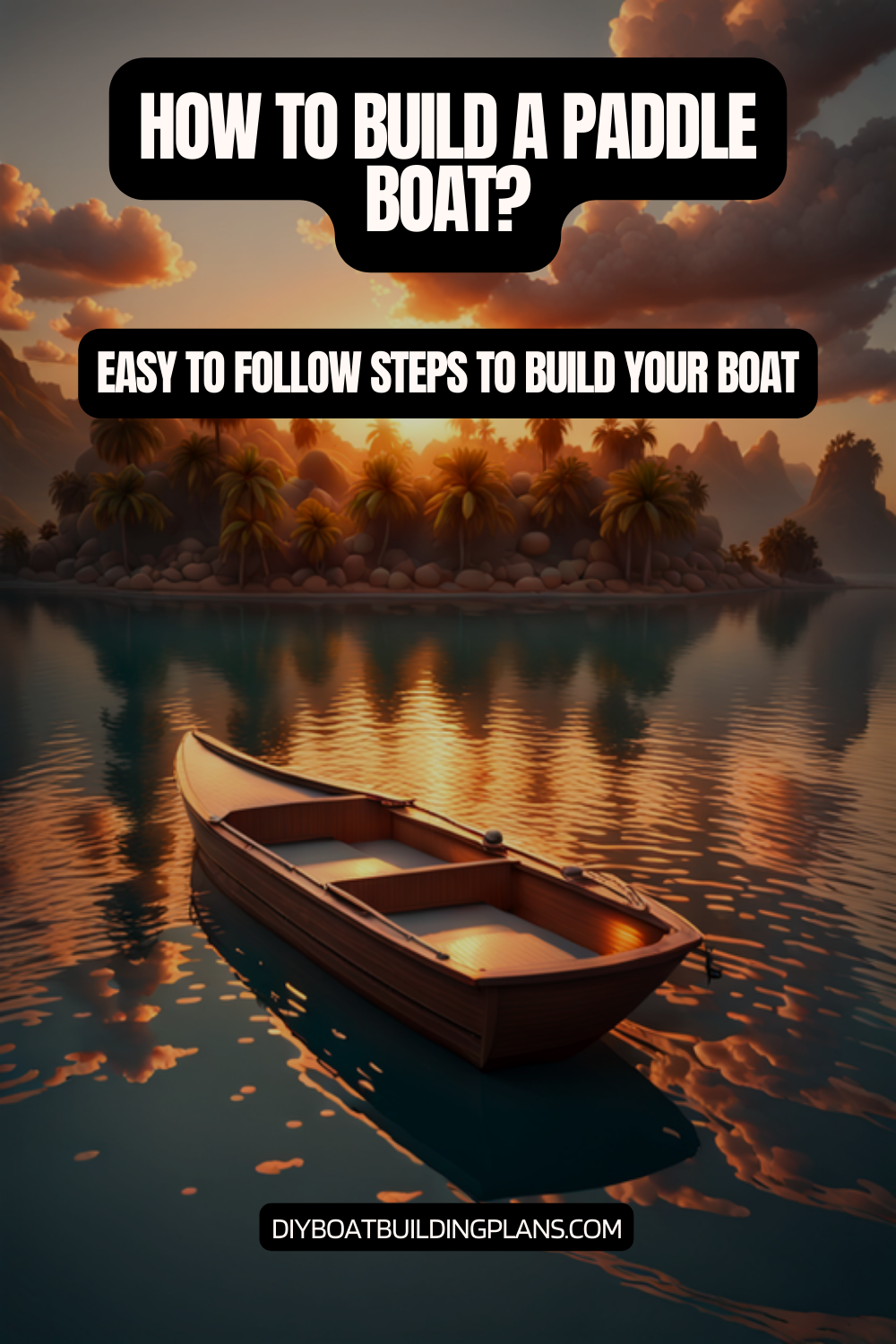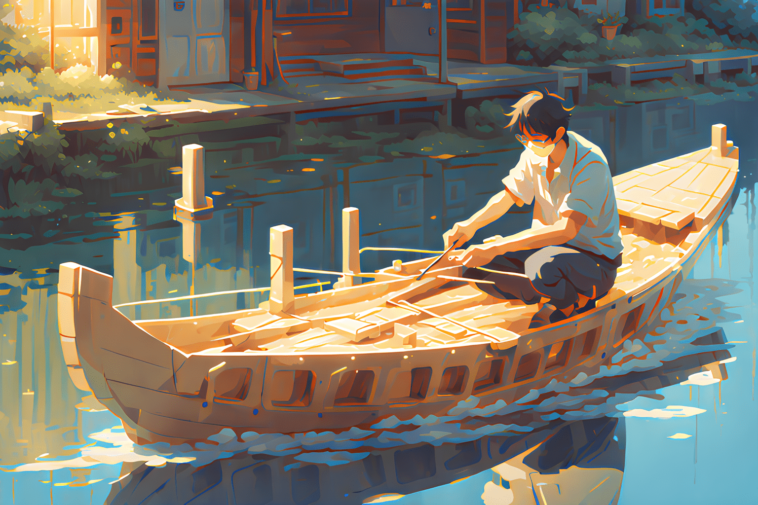Ever thought about turning simple household items into a fun paddle boat? Building your own DIY paddle boat is more than a weekend hobby. It’s a chance to dive into engineering and learn about science.
Homemade paddle boat plans let you explore physics, how things move, and energy. With items like plastic bottles, wooden sticks, and rubber bands, you can make a cool boat. It shows off complex science ideas.
This guide will show you how to make a paddle boat from everyday stuff. You’ll see how simple items can become a working boat that teaches engineering basics.
Key Takeaways – DIY How To Build a Paddle Boat at Home
- Learn the basics of paddle boat design using household materials
- Understand scientific principles like energy
- Develop hands-on engineering and problem-solving skills
- Create a functional watercraft through creative thinking
- Explore STEM concepts in an interactive, fun project

Understanding Paddle Boats
Paddle boats are a world of marine engineering that mixes creativity with mechanical skill. They use special paddle boat systems to move through water. This offers fun and a technical challenge for fans.
Paddle boats have changed a lot over time. They went from steam-powered to human-powered. Their design focuses on being efficient and fun.
Types of Paddle Boats
There are many paddle boat designs for different uses and places. Each has its own paddle boat system:
- Recreational pedal boats for lakes and calm waters
- Competitive racing paddle boats
- Historical steam-powered paddle wheelers
- DIY experimental paddle craft
Key Components of a Paddle Boat
Knowing the key parts is key to a good paddle boat design. Important parts include:
- Hull: The boat’s main structure that keeps it afloat
- Paddle Mechanism: Turns human or mechanical energy into movement
- Propulsion System: Controls the boat’s speed and how well it moves
“The art of paddle boat design is about turning energy into motion with smart mechanical ideas.”
For DIY fans, there are many paddle boat ideas to try with common materials. Using rubber bands to store energy lets you experiment with how well your boat works.
Tools and Materials Needed
Building a paddle boat needs the right materials and tools. It’s a fun project that mixes creativity with engineering. Choosing the right materials and finding affordable options can make your DIY project a success.
Essential Tools for Your Project
Before starting your paddle boat, you need the right tools. Here’s a list of tools you’ll need:
- Measuring tools: Ruler and pencil for precise measurements
- Cutting tools: Sharp scissors and utility knife
- Adhesive tools: Various types of tape (duct tape, packing tape)
- Sanding equipment: Sandpaper with different grits
- Safety gear: Protective gloves and safety glasses
Cost-Effective Materials for Paddle Boat Construction
Choosing the right materials can save you money without sacrificing quality. Here are some affordable options:
| Material | Cost | Durability |
|---|---|---|
| Recycled Plastic Bottles | Very Low | Moderate |
| 3/16″ Plywood | Low-Medium | High |
| Wooden Chopsticks | Very Low | Low |
| Plastic Milk Jugs | Very Low | Moderate |
“The key to a successful DIY paddle boat is creativity and resourcefulness in material selection.”
By picking the right tools and materials, you can build a paddle boat without spending a lot. Using everyday items can also save you money on your project.
Planning Your Paddle Boat Design
Starting your homemade paddle boat project means getting your design right. The success of your boat depends on good planning and design. Turning your ideas into a real boat needs both precision and creativity.
Good paddle boat design comes from knowing what you need and want. Designers must think about many things to make a great boat.
Sketching Your Design
Your journey starts with detailed sketches. Both pros and hobbyists suggest a few ways to begin:
- Create rough hand-drawn outlines
- Use graph paper for precise measurements
- Develop digital sketches using basic design software
- Draft multiple design iterations
“Every great paddle boat begins with a simple sketch and a vision of adventure.”
Calculating Dimensions and Specifications
Getting the measurements right is key for your paddle boat plans. Important dimensions include:
- Hull length and width
- Paddle wheel diameter
- Weight capacity
- Intended water environment
Creating good homemade paddle boat plans means paying attention to details. Remember, measure twice, cut once. This way, your design turns into a reliable and fun boat.
Unlock the secrets to building your dream boat with MyBoatPlans! With detailed plans for over 518 boats and expert video tutorials, you’ll have everything you need to create your perfect vessel. Click here to begin your journey!
Building the Hull
Making the hull is a key part of building a DIY paddle boat. The hull affects how well your boat performs, stays stable, and works. Picking the right shape and materials is important for a good paddle boat.
Selecting the Perfect Hull Shape
The hull shape you choose affects your paddle boat’s performance. Each design has its own benefits:
- Flat-bottom hulls: Great for stability
- V-shaped hulls: Better for speed and control
- Rounded hulls: Helps with water flow
Step-by-Step Hull Construction Process
When using materials for your paddle boat, be precise. Here’s how to build the hull:
- Choose 3/4″ marine plywood as your main material
- Measure and cut hull pieces with 2x12s for support
- Drill holes: 3/8″ down from the deck and 3/8″ forward from the stern
- Use router bits for smooth edges
- Apply resin to seal and protect the hull
“The success of your paddle boat lies in the careful construction of its hull.” – Boat Building Expert
For extra strength, add 4 oz. fiberglass cloth on the deck. Most DIY fans finish this part in an afternoon with materials from their garage.
Hull Thickness and Reinforcement
Go for a main body thickness of 1 inch. Make paddles and fins 3/8 inch thick. Use brass rods or rubber bands for paddle mechanisms. This ensures smooth movement and best performance.
Installing the Paddle Mechanism
Building a paddle boat needs careful planning and precise steps. The paddle mechanism is key to your boat’s speed, control, and performance. It’s what makes your homemade watercraft move smoothly.
Creating a good paddle mechanism involves several important steps. You want a system that turns your effort into smooth water movement.
Choosing the Right Paddle Type
The right paddle design is vital for your boat’s success. Think about these key points:
- Material durability (wood, plastic, or composite)
- Paddle wheel diameter
- Number of paddle blades
- Attachment method to the boat’s frame
Assembly of the Paddle System
Assembling the paddle system needs precision and care. For the best results, follow these steps:
- Measure and cut paddle wheel components accurately
- Use a 16″ steel wheel as the primary paddle wheel base
- Weld a 6″ bolt to the axle to extend paddle room
- Create paddle supports using 5″ bed frame pieces
“The success of your paddle boat lies in the detailed design of its propulsion mechanism.” – Boat Building Experts
Pro Tip: Make sure your paddle wheel can rotate freely but stays attached to the boat. Test it several times before you install it for sure, smooth operation.
With careful design and detailed assembly, your paddle boat will move smoothly across the water. It will turn your DIY project into a fun maritime adventure.
Adding Stability Features
Making a stable paddle boat needs careful thought on design and safety. Good design ideas are key to a boat that works well and keeps riders safe.
Stability comes from knowing about floatation and balance. Your boat’s success depends on how you spread weight and shape its core.
Understanding Floatation Dynamics
Good safety starts with the right hull design. Important things to think about include:
- Hull width and shape
- Weight distribution
- Material selection
- Buoyancy calculations
Implementing Stabilization Techniques
To make your boat more stable, try these design tips:
- Make the hull wider for better balance
- Add small outriggers for extra support
- Choose lightweight but strong materials
- Design with a low center of gravity
“A well-designed paddle boat is not just about movement, but about creating a safe and confident water experience.” – Nautical Design Expert
Pro tip: Always test your paddle boat’s stability in calm waters before venturing into more challenging conditions.
Constructing the Deck
Designing the deck of your homemade paddle boat is key. It affects both how well it works and how comfy it is. Your choices will depend on what you plan to do with it, like cruising or exploring.
- Available space for seating
- Weight distribution
- Intended water activities
- Personal comfort preferences
Versatile Deck Designs for Different Uses
Paddle boat customization options vary a lot. For casual use, a simple deck is fine. But, advanced builders might add storage or spots for fishing gear.
“The deck is more than just a surface – it’s the heart of your paddle boat’s functionality.” – Boat Building Expert
Adding Seating and Comfort Elements
Seating is very important in homemade paddle boat plans. Here are some ideas:
- Built-in bench seats
- Removable cushioned seats
- Ergonomic positioning
- Non-slip surface materials
Adding more to the deck should not make the boat unstable. Good design means it’s both comfy and works well.
Download over 500 Boat Plans. Click on the link below.
-->Click Here<--
Finishing Touches: Painting and Sealing
The final step in making your own paddle boat is to protect it with paint and sealant. These steps not only make the boat look good but also keep it safe from water and the environment.
Choosing the right paint and sealant is key. Different materials need different treatments to last long and stay protected.
Choosing the Right Paint
When picking paint for your paddle boat, think about these things:
- Water resistance
- UV protection
- Compatibility with boat material
- Color durability
Marine-grade paints are best for wooden and fiberglass boats. Acrylic marine paint is great because it covers well and fights off water and sun damage.
Applying Sealant for Durability
To protect your boat well, follow these steps for sealant:
- Clean and sand the surface well
- Apply primer that fits the boat material
- Use a marine-grade sealant
- Put on thin coats
- Wait for each coat to dry before adding more
“A good sealant is like armor for your paddle boat, protecting it from water, UV rays, and wear.” – Boat Building Expert
| Material | Recommended Paint | Sealant Type |
|---|---|---|
| Wood | Marine Acrylic | Spar Urethane |
| Fiberglass | Epoxy Marine Paint | Polyurethane Sealant |
| Plastic | Specialized Plastic Paint | Marine-Grade Adhesive Sealant |
DIY tip: Always test your paint and sealant on a small area first. This makes sure they work well together and look right.
Testing Your Paddle Boat
Building a paddle boat at home is exciting. It needs careful testing for safety and performance. Before you launch, follow some important steps to check its safety and how well it works.
Before testing, make a safe space. A small pool or a large bathtub is perfect for starting.
Safety Precautions Before Launch
- Check all parts are well connected
- Look for any leaks
- Make sure the paddle moves easily
- Check that all seals are tight
- Wear the right safety gear
Conducting Initial Stability Tests
Testing stability is key when making a paddle boat. Start with these checks:
- Put the boat in water gently
- See how it floats and balances
- Add weight slowly to test if it floats well
- Check if the paddle works well
*Knowing about physics can make your paddle boat better.*
Physics helps your paddle boat work better. It teaches you about STEM, like Newton’s Laws and energy.
| Test Parameter | Assessment Criteria |
|---|---|
| Buoyancy | Boat stays level, no tilting |
| Propulsion | Moves forward smoothly |
| Structural Integrity | No leaks or weak spots |
Be patient and watch closely when testing. Each test helps you make your boat better.
Maintenance Tips for Your Paddle Boat
Keeping your DIY paddle boat in good shape needs regular care. This care keeps your boat safe and fun to use. It also makes it last longer.
Good maintenance starts with knowing what to check often. Your boat is a big deal, so it’s worth protecting. It took a lot of time and effort to make.
Regular Care and Cleaning Routine
- Rinse the paddle boat with fresh water after every use
- Thoroughly clean with mild soap every 10 uses
- Inspect all moving parts and connections
- Check for signs of wear or damage
Protecting Your Paddle Boat from Environmental Damage
Many things outside can harm your boat. UV rays, saltwater, and moisture can wear it down. You need to keep them away.
| Environmental Factor | Potential Damage | Recommended Protection |
|---|---|---|
| Sunlight | Material weakening | Store in shaded area |
| Saltwater | Corrosion | Rinse thoroughly after use |
| Moisture | Potential rot or rust | Dry completely after use |
“Routine maintenance is the secret to making any watercraft last a lifetime” – Experienced Boat Craftsman
Identifying and Addressing Common Issues
Building a DIY paddle boat means you have to watch out for problems. Here are some common ones:
- Loose paddle mechanism
- Water leakage
- Rubber band deterioration
- Paint or sealant degradation
By following these tips, you’ll keep your boat in great shape. This way, you can enjoy the water for many years.
Exploring Paddle Boat Accessories
Turning your homemade paddle boat into a fun adventure requires the right accessories and safety gear. The right items can make your water trips more enjoyable and safer.
Essential Accessories for Fun
Adding cool accessories can make your paddle boat experience better. Here are some great ideas:
- Compact storage compartments for personal items
- Waterproof LED lighting for evening trips
- Detachable flags for visibility
- Small anchor system for stable positioning
Safety Gear Recommendations
Keeping safe is key for a fun paddle boat ride. Make sure to have these important safety items:
| Safety Item | Purpose | Recommended Type |
|---|---|---|
| Personal Flotation Device | Emergency buoyancy | Coast Guard Approved Life Vest |
| Waterproof Communication Device | Emergency contact | Sealed Marine Radio/Smartphone Case |
| First Aid Kit | Medical emergencies | Waterproof Compact Kit |
“Safety doesn’t happen by accident. Prepare, protect, and enjoy your paddle boat adventure!”
Remember, any changes should keep your paddle boat stable and functional. Choosing the right accessories will make your water trips memorable and safe.

Final Thoughts on Building Your Paddle Boat
Building a paddle boat is more than a weekend project. It’s a fun journey into engineering for all ages. It lets you learn about marine design and how things move.
Starting a paddle boat project opens up a world of creativity. You can try out different materials like balsa wood, copper tubes, and rubber bands. This helps you solve problems and think creatively.
Encouragement for Future Projects
Every paddle boat you make is a step towards bigger engineering challenges. Start simple and then try new things like different propellers or bigger containers. You’ll learn a lot, from keeping things stable to using tools well.
Resources for Further Learning
Keep learning by checking out online maker groups, local STEM workshops, and engineering forums. There are many free resources and plans available. Remember, every big inventor started small, so keep exploring and trying new things.
FAQ
What are the basic materials needed to build a paddle boat at home?
You’ll need items like plastic water bottles, wooden chopsticks, and rubber bands. Also, milk jugs, cereal boxes, scissors, a ruler, and tape (duct tape, packing tape). For more complex designs, consider 3/16″ plywood.
How difficult is it to build a paddle boat for a beginner?
Building a paddle boat can be simple or a bit harder. Beginners can start with easy designs using household items. More advanced designs need precise measurements and special materials.
What is the primary mechanism that makes a paddle boat move?
The main way it moves is through a paddle wheel. This wheel uses energy from a twisted rubber band to push the boat forward.
How can I ensure my homemade paddle boat remains stable in water?
Make sure it’s stable by designing a balanced hull. Spread the weight evenly and add small outriggers if needed. A wider hull base helps with stability. Test it in calm water and adjust as necessary.
What safety precautions should I take when testing my paddle boat?
Always test in a controlled area like a bathtub or small pool. Check for leaks and that the paddle works right. Wear safety gear, have flotation devices ready, and never test alone.
How do I waterproof my homemade paddle boat?
Use waterproof paint that fits your materials. For wood, apply marine-grade varnish or sealant. Seal all seams and joints to keep water out. Make sure to cover everything evenly for the best protection.
Can this be an educational project for children?
Yes! Building a paddle boat is a great STEM activity. It teaches engineering, physics, and design. It’s a fun way to learn about how things move and work in water.
How long does it typically take to build a simple paddle boat?
A simple paddle boat can take 2-4 hours for beginners. More complex designs might take a day or more, depending on the design and your skills.
What maintenance is required for a homemade paddle boat?
Rinse it with fresh water and let it dry after each use. Check for loose parts and wear on the paddle. Reapply sealant or paint as needed. Store it in a dry place to avoid damage.
Can I customize my paddle boat after building it?
Yes! You can add things like small flags, LED lights, or cargo areas. Just make sure any additions don’t affect the boat’s stability or how it works.



